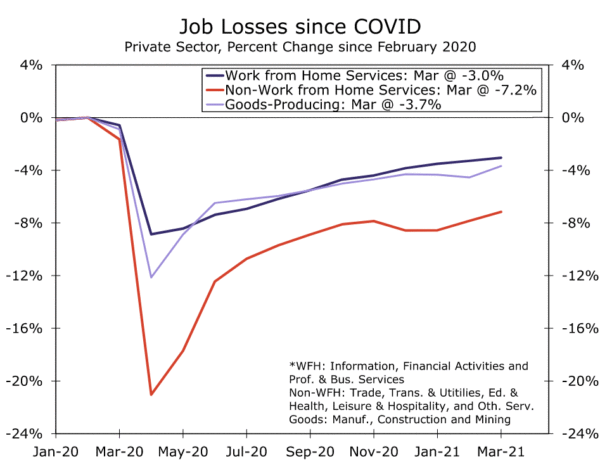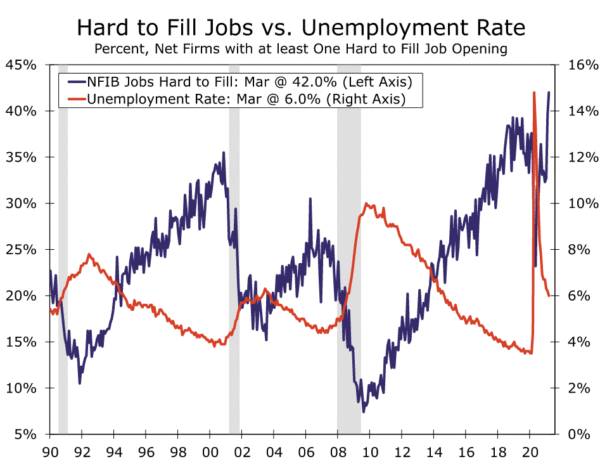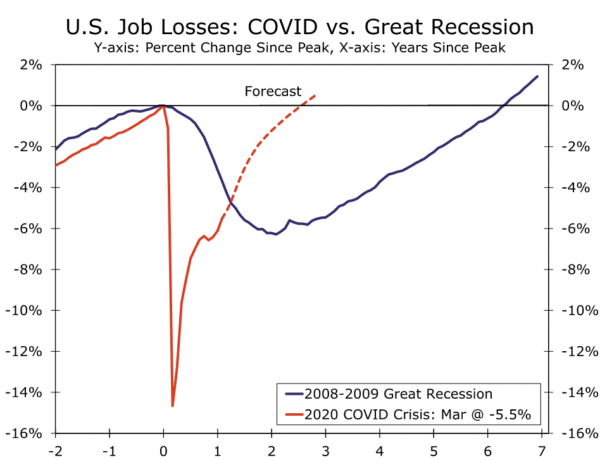Summary
Hiring stepped up in a major way in March, with employers adding 916K new jobs. More workers returned to the job market and the unemployment rate edged down to 6.0%. While there is still a lot of ground to make up, the labor market is on track for a relatively quick recovery.
Signs of “Normal”
The economy took a big step closer to a full recovery with today’s jobs report. Employers added 916K new jobs, handily beating expectations. Job gains over the past two months were revised higher as well, but the March figure still denotes a significant pickup from the first two months of the year.
The broader re-opening of the economy, growing optimism that the end of the pandemic is in sight and a reversal of last month’s unseasonably cold weather generated broad gains in hiring. Construction hiring more than reversed last month’s decline, while manufacturing employment rose by the most in six months as demand for both consumer and capex goods remain solid. In-person service jobs also posted notable gains, including 94K in trade & transportation, 280K in leisure & hospitality, 64K in private education and 42K in other services. Public sector hiring rose by 136K, led largely by state & local education as the shift back to in-person learning moved along. In another sign school and work is moving back toward “normal”, the share of employees teleworking specifically because of the pandemic fell to 21.0%, the lowest rate yet.
Signs of Gradual Tightening
Even with widespread hiring in March, COVID’s disproportionate effect on high-contact industries remains. The varying degree to which the pandemic has hurt or helped different industries has kept the unemployment rate elevated despite a record share of businesses reporting at least one position as hard to fill. While manufacturers have reported record job openings in recent months, the skills of bartenders and restaurant servers do not immediately transfer, and available jobs might be far from hospitality centers. Moreover, the incentive to switch occupations or move is reduced as the end of the pandemic comes into view. Childcare and health concerns remain a staffing challenge unique to a pandemic-induced downturn as well.
That said, the labor market is tightening. The unemployment rate slipped to 6.0% from 6.2% in February, while the labor force participation rate edged higher. Accounting for both labor force leavers and the unemployed, the employment-population ratio (E-Pop) remains below the trough of the Great Recession. However, honing in on prime-age workers, the E-Pop ratio jumped 0.3 points in March and is in line with its 2014 rate, just like the overall unemployment rate.
More to Come for a Relatively Fast Recovery
With the recent deployment of more fiscal support, easing restrictions and rising optimism, we expect the jobs recovery to gain further momentum in the coming months. Labor force participation should continue to increase with the broadening demand for workers, helped also by vaccination efforts and the return to in-person learning.
Overall, the aggressive policy support and speed of this cycle should limit labor market scarring. The number of permanent job losers remains about half the levels of Great Recession, with workers on temporary layoff still accounting for a relatively high share of job losers at 20.8%. There remains a significant jobs deficit at 8.4 million, but it is being chipped away at quickly. With spending about to boom, its closure is looking closer and closer.
We continue to expect the Fed to emphasize that there remains significant ground to recover, and that the labor market recovery remains uneven. That should keep policy easy for a while yet, but the FOMC may not be able to point to the jobs market as a reason to look through rising inflation pressures as long as previously thought.
















